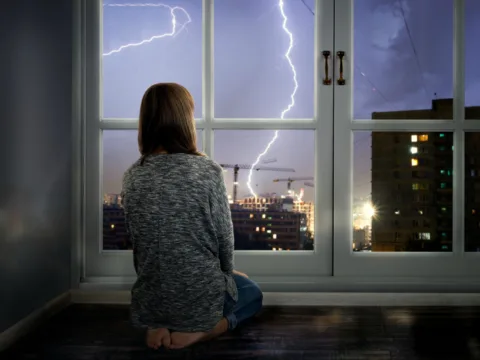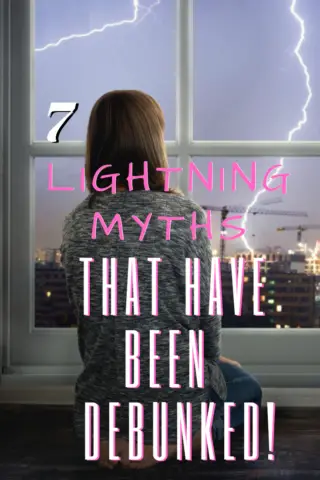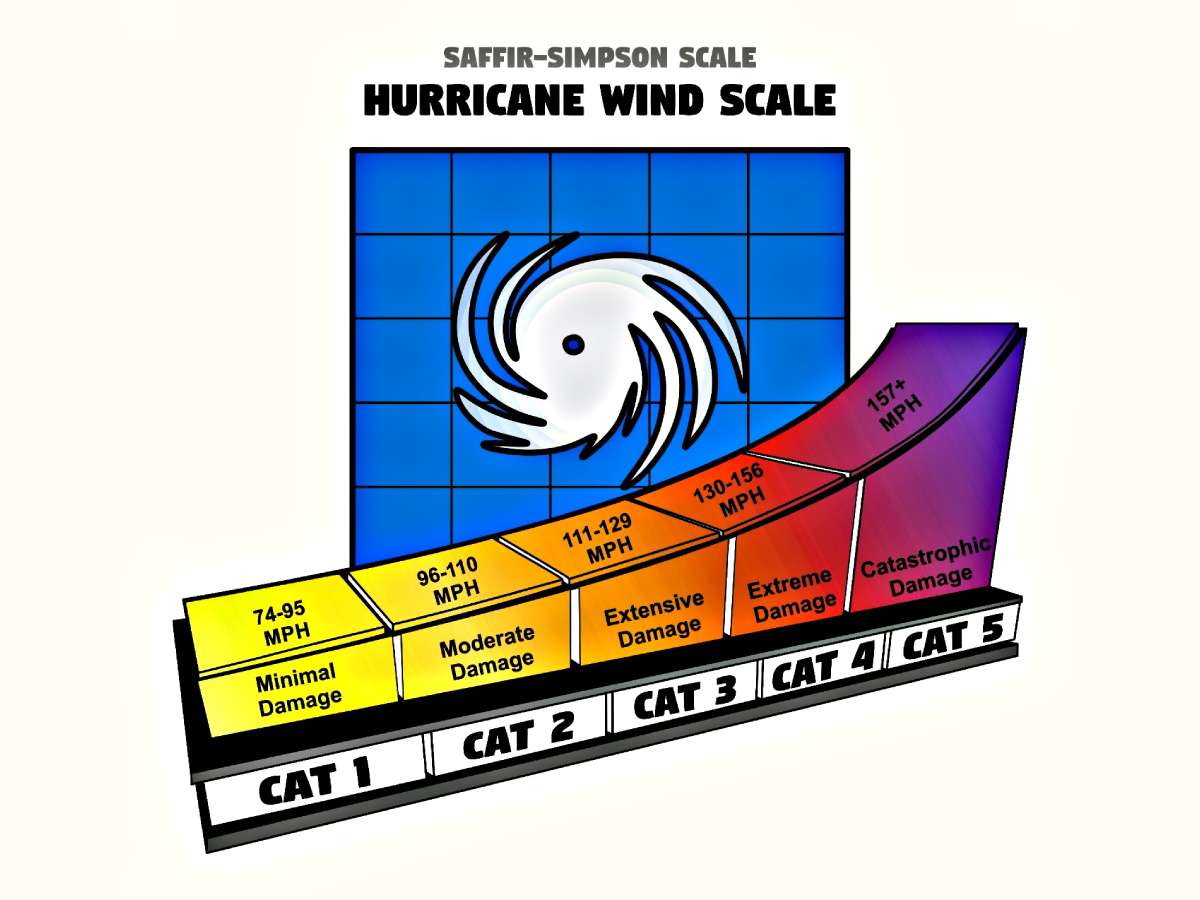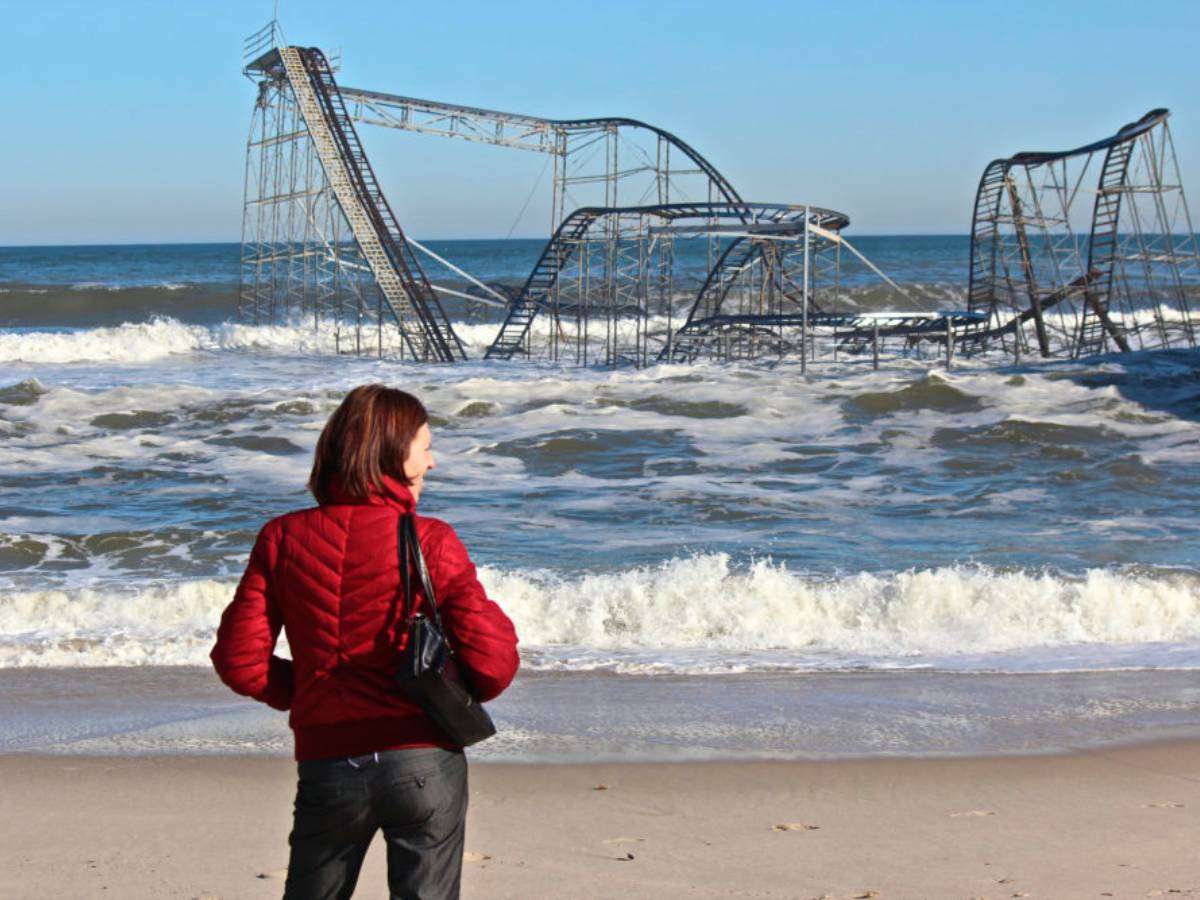As a Florida guy, I’ve heard many of the popular lightning myths.
For example, I’ve heard that you can’t get hurt from lightning if you’re inside your home.
But it turns out even that isn’t true!
What other misinformation and myths about lighting can put you at risk of severe injury or even death?
Today I’m going to debunk some of the most popular lightning myths and share many lightning safety tips with you along the way.
Must read: How Hot Is Lightning? (The answer may shock you.)
Myth #1 – You’re Safe From Lightning If You’re Inside Your Home
FACT: You can be injured or killed by lightning inside your house.
In my Central Florida metropolitan area alone, there have been several homes struck by lightning over the past couple years.
So, what happens when a home is struck by lightning?
Usually, it results in a fire that begins in the attic or walls of the house, and it consumes the rest of the structure rather quickly.
These fires can begin without you even knowing about it at first — not until smoke starts sifting through the house or flames begin licking through the ceiling or walls.
Many victims of home lightning strikes report hearing a loud “BOOM” at the moment the home is struck by lightning.
Specific lightning dangers inside a house
House fires caused by lightning aren’t the only way you can be hurt by lightning inside your home.
Lightning wants to find the fastest way from the cloud to the ground — and things like metal pipes, wires, cables, gutters, water, and metal windows all help lightning accomplish this goal.
When lightning strikes your home, it will travel toward the ground putting anything that is in the path of one of those conductive objects at risk.
Injury (or even death) can occur if you happen to be holding or using corded electronics, taking a shower, or using a sink when lightning strikes your house.
Lightning can even jump across a room, traveling from a wall outlet to a pipe or faucet in the pursuit of the ground. Crazy, huh?
Also creepy?… Lightning can even travel through cracks in windows.
Lightning Safety Tip: During a thunderstorm, avoid using corded phones and electronics. Don’t take showers. And stay away from windows. These are the ways that you are most vulnerable to lightning strikes inside the home during a storm!
It’s impractical to avoid all electronics every time there’s a thunderstorm, but there really is a risk to using a computer or sit in front of a plugged-in television while lightning strikes outside. And, sometimes, you don’t even need to be touching something to get struck. –Forbes
Myth #2 – Lightning Only Happens When It’s Raining
FACT: I love Fleetwood Mac’s 1977 hit “Dreams,” which contains the lyrics “thunder only happens when it’s raining.” Yes, thunder (and its preceding lightning) generally do happen when it’s raining, but sometimes lightning occurs before rain.
This happened in Venice Beach, California during a summer day in 2014. It took people off guard and sadly ended up killing one person and injuring 13 others.
It does not have to be raining for lightning to strike — and this is what’s so dangerous and unpredictable about lightning.
You see, most folks who are outdoors will seek shelter the moment it starts raining. But few come indoors simply when the clouds are darkening — but they should:
Lightning Safety Tip: Anytime it’s looking stormy outside — even if there’s no rain or lightning — it’s best to seek safe shelter as soon as possible because it doesn’t have to be raining in order for lightning to strike!
Myth #3 – Lightning Can’t Strike You If There Aren’t Any Clouds Overhead
FACT: Lightning travels far and fast — so while there may not be clouds directly overhead, nearby lightning could send its tentacles your way.
Ever hear of the old phrase “bolt from the blue”? It’s not just an ironic saying — it’s something that can actually happen.
Lightning can travel as far as 25 miles from its parent storm. So, even if the sky above you is as clear as could be, if a storm is brewing a few miles away — say the next town over from you — it could still send an injurious (even fatal) lightning bolt your way.
Some rather old-fashioned weather advice is… If you see lightning, start counting off the seconds. One Mississippi, two Mississippi, three Mississippi, etc. If you get to 30 Mississippi or longer before hearing thunder, they say you’re fine. For every 5 seconds you count off, lightning is 1 mile away — 2 miles away if you get to 10 seconds, and so on.
However, science has proven that lightning can do damage much farther just 5 or 6 miles from its parent storm.
The new, much safer advice is… If you hear thunder at all, seek shelter immediately — because anytime you can hear thunder, you can potentially be struck by lightning.
No matter what I’m doing, if I’m outdoors and hear thunder, I always make a point to drop what I’m doing and head right for the nearest safe shelter.
Lightning Safety Tip: If you see storm clouds gathering a few miles away, head indoors — and don’t go back outside until you haven’t heard any thunder for at least 30 minutes.
Myth #4 – Lightning Only Happens In The Summer
FACT: Oye veh, where do these myths come from? This is definitely false.
OK, so it sort of makes sense why some folks think lightning strikes only in the summer — after all, summertime is when thunderstorms are most prevalent.
This is due to the intense heating from the sun, which can cause instability in the lower atmosphere. And this gives rise to the turbulence necessary to cause the growth of thunderheads, which can bring torrential downpours, strong winds, and — yes — lightning and thunder.
But… thunderstorms don’t happen only in the summer!
What happens in the fall, when the first cold fronts blow through, bringing cooler weather?
Normally, a fall cold front brings with it squally weather — including heavy rain, strong winds, and frequent lightning.
For example, here in Florida, we get many lightning storms during the squalls that precede cold fronts. And we usually get only a little piece of that stormy cold front action in Florida. But further north, cold fronts can bring terrible thunderstorms in the fall months.
And there’s spring… Ah, spring. Flowers are blooming, the weather is warming up, and AGH — thunderstorms!
Yep, the milder spring weather is generally ushered in after the passage of warms fronts, and these are often accompanied by bands of rains — and sometimes lightning.
And if you live in Tornado Alley, not only does springtime mean a heightened chance of tornadoes, but it also brings along other forms of severe weather — including lightning.
Winter isn’t immune to thunderstorms, either. In fact, lightning can even occur during blizzards! Lightning in the snow is actually a pretty fascinating (though dangerous) weird weather phenomenon called thundersnow.
Check out this video of thundersnow and you’ll see what I mean:
Lightning Safety Tip: Lightning may strike anytime that severe weather is occurring. So, stay fresh on your lightning safety preparedness and be ready to take safe shelter from lightning year round — during the spring, summer, fall, and yes… even in the winter!
Myth #5 – Lightning Never Strikes The Same Place Twice
FACT: This is one of the most common lightning myths, and it can be easily debunked by pointing to the Empire State Building. That iconic New York City skyscraper is struck by lightning an average of 23 times each year!
Mountains, bridges, and radio antennas are among the many other places that are struck by lightning repeatedly over the course of a year.
So, yes… it’s been proven that lightning can — and often does — strike the same place twice.
Lightning Safety Tip: Lightning can strike anywhere once and many places twice (including tall buildings, mountains, bridges, and radio antennas) — so if there’s a storm nearby, stay as safe as possible indoors and avoid tall outdoor structures.
Myth #6 – If You’re Caught Outside During Lightning, You Should Lay Flat On The Ground
FACT: When lightning hits the ground, it sends out currents several feet all around the strike zone — so, laying flat on the ground can actually increase your chances of being hit by the dangerous currents and horizontal arcing emanating from nearby lightning strikes.
If you’re caught outdoors during a lightning storm, the best and safest thing you can do is seek safe shelter indoors as quickly as possible.
Trees, tents, and freestanding pavilions do not count as safe shelter!
If the only shelter you have is a car, then get inside and stay off electronic equipment.
Must read: What To Do If Lightning Strikes Your Car
Lightning Safety Tip: If you can’t find (or get to) safe shelter and you’re in an open area, crouch low to the ground on the balls of your feet to minimize your contact with the ground and lower your risk of shock from nearby strikes — and stay at least 20 feet away from other people to decrease the risk of more than one person getting struck.
Myth #7 – Heat Lightning Isn’t The Same As Regular Lightning
Totally false! There is no such thing as heat lightning… Heat lightning is “regular” lightning that is so far away it can’t be heard.
Heat lightning probably got its name from the occurrence of summer evening lightning storms seen from afar.
At night, you can see cloud-to-cloud and cloud-to-ground lightning from many miles away! In fact, I’ve seen lightning illuminating high cloud tops at night more than 150 miles away, as confirmed by Doppler radar data.
But that’s just a very tall and active thunderhead at a distance over the horizon. So while the illumination from the lightning is perfectly visible in the dark of night, the thunder is just too far away to hear it.
So-called heat lightning, by definition of being very distant lightning, is generally safe to observe outdoors presuming its at least 25 or 30 miles away.
That said… be sure to always seek shelter if you can hear thunder!
Lightning Safety Tip: Seeing flashes of lightning in the distance should tell you that the atmosphere is ripe for thunderstorm development. Therefore, whenever you see heat lightning, it’s best to bring your activities indoors and heed the advice mentioned in #1 above for the next few hours.
The Bottom Line…
Share the facts about lightning and help put and end to all of these bad lightning myths.
Follow the helpful advice mentioned in each of the lightning safety tips above.
Anytime there’s a storm nearby, do your part to stay safe — whether you’re inside or outside!
Must read: I Was Struck By Lightning When I Was Pregnant
Like this post? Save it to read again later… or share with others on Pinterest!






